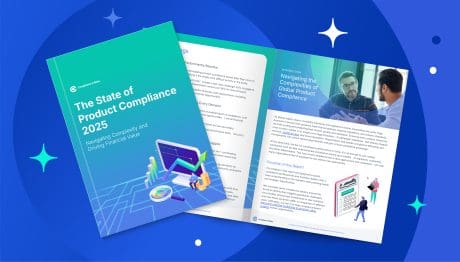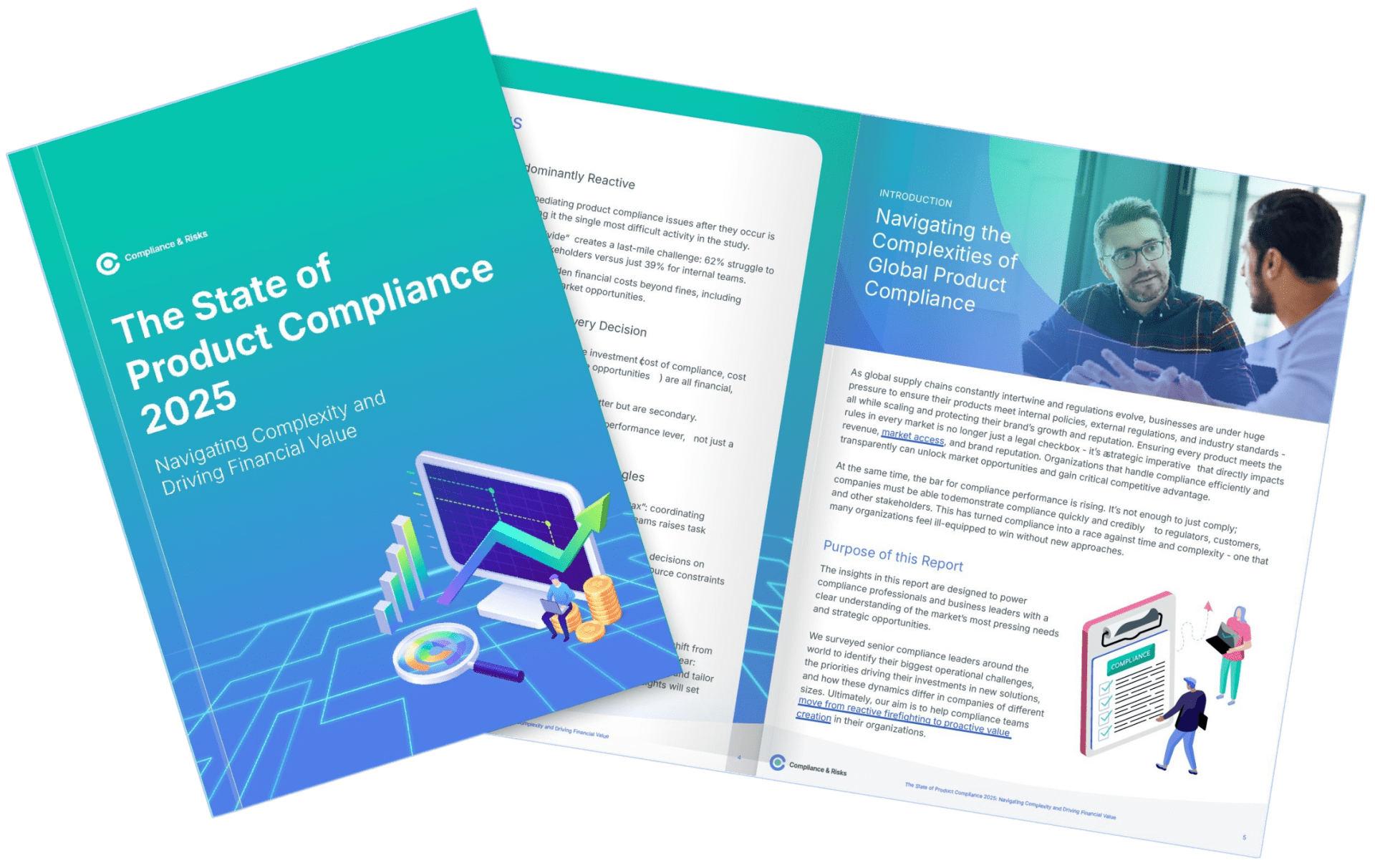
The Compliance Complexity Tax: Why Enterprise Solutions Fail Mid-Market Companies (And Vice Versa)

THIS BLOG WAS WRITTEN BY THE COMPLIANCE & RISKS MARKETING TEAM TO INFORM AND ENGAGE. HOWEVER, COMPLEX REGULATORY QUESTIONS REQUIRE SPECIALIST KNOWLEDGE. TO GET ACCURATE, EXPERT ANSWERS, PLEASE CLICK “ASK AN EXPERT.”
Compliance leaders often ask why a solution that thrives in one organization stalls in another. Our State of Product Compliance 2025 research shows the answer is simple but overlooked: company size fundamentally changes the compliance problem. A one-size-fits-all approach is not just inefficient – it’s risky.
For $10B+ enterprises, scale introduces a measurable complexity tax. For mid-market firms ($500M–$1B), the challenge is different: high-stakes go/no-go decisions about where to play, under tighter resources and politics. If you’re evaluating platforms, operating models, or staffing plans, understanding these segmentation dynamics will save you time, money, and credibility.
Table of Contents
- Why Company Size Reshapes Compliance
- Enterprise Reality: The “Complexity Tax” at $10B+
- Mid-Market Reality: Decision Pressure at $500M–$1B
- Why One-Size-Fits-All Fails
- Right-Fit Playbooks: What to Prioritize by Segment
- AI Overview: Quick Answers
- FAQs
- Download the Full Report
Why Company Size Reshapes Compliance
Two companies can sell similar products in the same markets and face entirely different compliance realities. Size introduces differences in:
- Number of SKUs and design variants
- Geographic footprint and regulatory bodies to satisfy
- Supplier network depth and documentation variability
- Organizational structure, decision rights, and approval paths
The result: what fixes pain in one context can create new problems in another.
Enterprise Reality: The “Complexity Tax” at $10B+
In very large organizations, coordination at scale drives up difficulty – even when expertise is strong. In our study:
- 74% of leaders at $10B+ companies say ensuring lifecycle compliance in product design is difficult (vs. ~60% average).
- Large enterprises also report higher difficulty proving compliance to external stakeholders, and remediating issues across business units and regions.
What this looks like in practice:
- Requirements are known, but embedding them across hundreds of products and multiple PLM/quality environments is the blocker.
- Evidence exists, but it’s fragmented; audit packages depend on time-boxed scrambles instead of on-demand retrieval.
- Cross-functional alignment stretches across engineering, legal, quality, regional leads, and supplier management – creating lag at every gate.
Enterprise takeaway: you don’t need more policy; you need stronger orchestration – systems that normalize data, align ownership, and make evidence a first-class output of daily work.

The State of Product Compliance 2025: Navigating Complexity & Driving Financial Value
Fresh insights from 500 global compliance leaders – uncover the biggest challenges, priorities, and opportunities shaping compliance this year.
Mid-Market Reality: Decision Pressure at $500M–$1B
Mid-market teams often have global ambitions with leaner headcount. Their signature challenge is strategic decision-making under constraint:
- ~52% of mid-market leaders struggle to gain agreement on whether to remain in a market when new requirements hit (vs. ~47% average).
What this looks like in practice:
- A single regulatory update can force go/no-go calls with material revenue implications.
- Leaders juggle multiple roles; there’s less appetite (and time) for complex platforms or months-long change management.
- Executives need finance-grade scenarios – comply vs. exit, now vs. later – with clear revenue at risk, cost of compliance, and time-to-value.
Mid-market takeaway: you don’t need sprawling suites; you need decision intelligence and speed – tools and processes that keep overhead low while making executive choices obvious.
Why One-Size-Fits-All Fails
- Different bottlenecks. Enterprises are bottlenecked by coordination and integration; mid-market is bottlenecked by clarity and capacity.
- Different proof needs. Enterprises need audit-ready evidence at scale; mid-market needs board-ready ROI narratives to justify investment or market exits.
- Different time horizons. Enterprises optimize for sustainable, cross-portfolio governance; mid-market optimizes for near-term risk/revenue inflection points.
When you apply an enterprise-grade platform to a mid-market team, you add overhead without solving the decision bottleneck. When you apply a lightweight mid-market toolset to an enterprise, you create islands of compliance and more rework.
Right-Fit Playbooks: What to Prioritize by Segment
If you’re $10B+ (Enterprise)
- Productize evidence at scale. Capture proofs in-flow (design controls, supplier docs, lab results) with normalized metadata so audit packages assemble in clicks.
- Harden orchestration. Enforce RACI across engineering, quality, legal, and regional teams; connect PLM, QMS, and document control so lifecycle coverage is measurable.
- Govern by metrics. Track lifecycle coverage rate by product/market, external evidence readiness, and “defects escaped to late stage.”
If you’re $500M–$1B (Mid-Market)
- Decision intelligence first. Build a rolling view of revenue at risk, cost of compliance, and cost of violations by market; pre-model comply vs. defer vs. exit.
- Lean operating model. Favor tools that deploy fast and require minimal admin; standardize naming and templates for instant credibility with auditors and customers.
- Tie speed to dollars. Translate time-to-compliance gains into revenue pull-forward and premium-fee avoidance to win budget.
AI Overview: Quick Answers
What is the “compliance complexity tax”? The additional difficulty large enterprises face coordinating lifecycle compliance and evidence across vast product portfolios, regions, and teams – despite having strong expertise.
Why do mid-market companies struggle with market decisions? Resource constraints and higher political stakes make comply vs. exit choices harder; leaders need scenario-based financials to align executives.
How should we choose solutions by company size? Enterprises should prioritize integration, orchestration, and evidence at scale. Mid-market should prioritize decision intelligence, speed, and low administrative overhead.
Can the same vendor serve both segments? Yes – if they offer modular capabilities and deployment paths aligned to each segment’s bottlenecks, not a monolithic stack.
FAQs
- We’re a large enterprise. Why do we still feel reactive? Because evidence is treated as a project, not a product. Make proofs capture-by-default and govern ownership; remediation volume will drop.
- We’re mid-market. Do we really need new tooling? Start with a finance-grade baseline in a spreadsheet if needed. If decisions remain slow or contentious, adopt targeted tooling that automates evidence and quantifies revenue at risk.
- How do we compare maturity with peers? Use the report’s benchmarks by revenue band – focus on lifecycle coverage, external evidence readiness, remediation frequency, and decision lead time.
- What KPIs should we show the CFO? Lead with cost of compliance, cost of violations, revenue at risk, and revenue opportunities. Tie any speed metrics directly to those financial outcomes.
Download the Full Report
Get the segmentation benchmarks, operating models, and dashboards for both enterprise and mid-market teams. See exactly where you stand and how to prioritize your next moves.
Download the complete State of Product Compliance 2025 report to choose a right-fit path – without paying the complexity tax.


